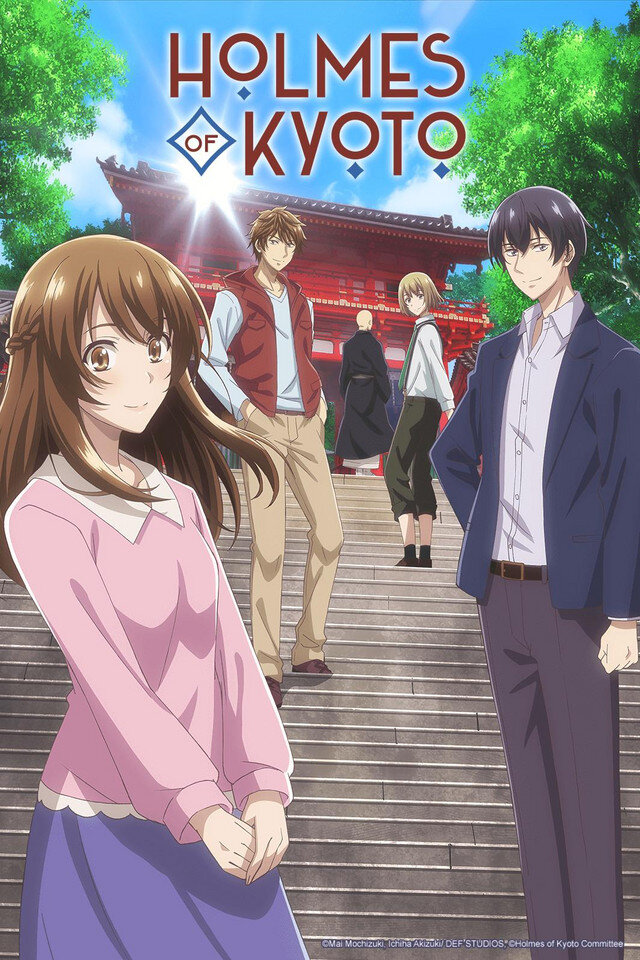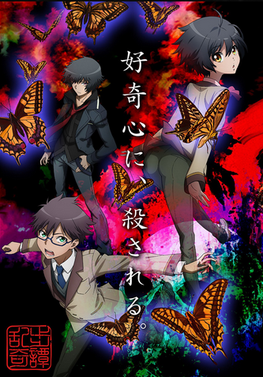As I’m in the midst of writing a paper on Sherlock Holmes in Japanese popular culture for Canadian Holmes, Journal of the Bootmakers of Toronto, I thought I’d share some of my favorite anime adaptations of the Great detective, as well as some mystery anime that I’ve recently finished watching. Since the province is still under lockdown, at least in Ontario, I encourage you to watch them online or purchase the Blue-ray & DVDs!
To begin, the genre of Holmesian anime (anime that adapt stories and characters from Sir Arthur Conan Doyle’s Sherlock Holmes) is not new. In fact, it can be traced to the revival of the authentic school of Japanese detective fiction, which sought to restore classic puzzle mysteries and tales of ratiocination such as by Edogawa Rampo and Yokomizo Seishi. During the late 1980s and 1990s, the majority of these stories were being published as novels, but also in the form of manga (Japanese comics). Although mystery manga were perceived as something less than their novel counterparts, they were immensely popular and widely read by the masses. Some of the most iconic mystery/detective anime from the 1990s such as Meitantei Konan (translated to Case Closed in North America) are adaptations of their manga originals. Additionally, I’d argue that the number of original, or stand alone mystery anime series has increased since the early 2000s. One great example is Kabukichō Shārokku, (Sherlock of Kabukichō) produced by Production I.G.
(c) Production I.G.
1. Kabukichō Shārokku (2019) | Sherlock of Kabukichō
If you like classic mysteries mixed with a bit of vulgar comedy and a lot of unexpected twists and turns, then, this anime is for you! Kabukichō Shārokku is probably one of the most intriguing adaptations of Sherlock Holmes to date. This anime series is well-researched, which is evident in its careful attention to details from Doyle’s original stories and characters, as well as BBC’s Sherlock (i.e., season four). It also draws inspiration from Rampo’s boys’ detective stories. This anime hasn’t been translated yet, and I’d imagine that it would be quite a feat to do so, as there are numerous Japanese cultural references, sexual innuendos, use of slang and jokes that would lose their impact and nuance in English.
While a lot of great things could be said about the anime, one of the most fascinating aspects of Kabukichō Shārokku lies in its fusion of neo-Victorian and “noir-esque” elements within a culturally distinctive sekaikan (world). The representation of Sherlock Holmes, (whose facial features remind me of Jeremy Brett) embodies this cultural fusion, who solves mysteries through rakugo, a traditional Japanese form of storytelling (kind of like a one-man show). The anime also hosts a number of iconic characters from the Holmesian canon, including Mrs. Hudson, but don’t expect to encounter a sweet and modest housekeeper. In the world of Kabukichō Shārokku, Doyle’s characters are playfully rendered in, sometimes, very unexpected ways.
Mrs. Hudson is not only a flamboyant bar owner, but also the ring leader of a group of crime fighters, including Sherlock Holmes, who all compete to solve mysteries to win cash prizes from her (him?)—you’ll have to watch the anime to figure that out yourself. Or see the character profile here.
Some of you may already know that Kabukichō is a reference to the entertainment and red-light district of Tokyo, Japan. More specifically, this anime is set in the East End of Kabukichō, drawing a parallel to the East End slums of Victorian, London, which was notorious for its crimes—most notably the Whitechapel murders committed by the infamous Jack the Ripper. So, it’s no surprise that the first twelve episodes of the anime revolve around a series of gruesome murders (committed by Jack the Ripper) and involves Holmes and his gang solving a number of cases that lead them to the killer. The latter twelve episodes focus on Moriarty’s gradual rise as a criminal mastermind that culminates in his epic mind game with Holmes.
Overall, I really appreciated the depiction of Holmes in this anime. He may not be a faithful representation of Doyle’s, but that’s what makes Holmes of Kabukichō so interesting. He has his quirks (he loves to eat sweet and savory things together), he has his odd moments and he is a master detective, but the anime also depicts a more human and slightly more vulnerable version of Doyle’s Holmes.
For more info about the show, and its franchise, check out their homepage and Twitter.
(c) Studio Seven. You can watch this anime on crunchyroll!
2. Kyoto Teramachi Sanjō no Hōmuzu (2018) | Holmes of Kyoto
If you want to learn about Japanese antiques and the rich cultural history of Kyoto, then, this anime is for you! What I love about this anime is how it re-imagines Doyle’s characters to tell a very curious story of Sherlock Holmes and Watson. Originally published as a series of light novels in 2015, Mochizuki Mai’s works have now been adapted into manga and anime.
In Kyoto Teramachi, don’t expect to find a detective. In fact, the protagonist of the series, Kiyotaka Yagashira (aka Holmes) hates being called a tantei (detective) because he takes pride in his profession as an antique appraiser. In other words, Kiyotaka is the Sherlock Holmes of the “antiques world,” but once in a while he is asked to solve strange mysteries. Although Kiyotaka has astute observational powers, he often relies on intuition to crack cases and to differentiate fake antiques from real ones. Kiyotaka’s method of “detection,” I thought, was a radical departure from Doyle’s original stories (and to the genre of detective stories more generally) that emphasize the use of inductive and/or deductive reasoning to solve a mystery. Like Holmes, however, who was a Victorian/Edwardian gentleman, Kiyotaka upholds idealized standards of proprietary and decorum unique to Kyoto. He’s an ikemen kara sure to pull the heartstrings of many otome viewers.
The anime begins when, one day, Kiyotaka hires a high school student named Aoi Mashiro (the girl version of Watson) to help him run the antique shop. The 12-episode series follows their adventures together as they go around the city, appraising some of the rarest antiques. Of course, no Holmesian adaptation is complete without Holmes’s archenemy, Moriarty. In the anime, Moriarty, or Enshō, takes the form of a genius con artist and scammer, who produces and sells replicas of rare antiques. Will Kiyotaka find Enshō and stop him from a life of scamming? Or will Ensho outsmart the great detective, I mean, the great appraiser? And what becomes of the romance between Kiyotaka and Aoi? You’ll have to watch the anime to find out! Check the anime's homepage for more info!
(c) Funimation | Studio Lerche.
3. Rampo Kitan: Game of Laplace (2016)
Last but not least, the third anime on my list is Rampo Kitan: Game of Laplace, which is not a Holmesian adaptation, but an anime adaptation of the works of Edogawa Rampo and his boy detectives. This anime series was created as a tribute to Rampo (to commemorate the 50th year since his passing). If you don’t know who Rampo is, consider him as Japan’s equivalent to Edgar Allan Poe. He’s known as the godfather of Japanese detective fiction. Many of his famous stories such as The Human Chair (1925) and characters from his “juvenile” fictions featuring the boy detectives and the masked thief Nijū Mensō (The Man with the Twenty Faces) have been adapted in the 11-episode series.
This anime is not for the faint-hearted. If you can handle horror, a little gore and the grotesque, this anime is for you. The first case, for example, involves the murder of a homeroom teacher whose body is dismantled and disfigured into a chair. But, thanks to Yoshio and Sōji, and with the help of the famous youth detective Akechi, the boys manage to solve a string of gruesome cases of murder and kidnappings.
For those familiar with Rampo’s boys’ detective stories you’ll either find Rampo Kitan intriguing or shocking, or both. The boy detectives of Rampo Kitan have shed their innocence and playful encounters with Nijū Mensō. And, Nijū Mensō himself becomes a symbol of vigilantism, which somewhat deviates from the original stories in which he once stated that he can’t stand the sight of blood. Nonetheless, this anime series weaves the world of Rampo’s works, re-centering boys as detective agents who expose the insufficiency of Japan’s judicial system, which perhaps, is a sorrowful reminder of the social injustices that continue to be committed against society’s most vulnerable—women, children and youth—in the real world. Overall, this anime captures the essence of the ero-guro aesthetics akin to Rampo’s fiction, and for those who like a slightly darker anime, you’ll definitely find this series entertaining. See the homepage for cool info about the series!
There are many, many more mystery anime that I could talk about! I just finished watching a series called Trickster: Edogawa Rampo "Shōnen Tanteidan" Yori (2016) and I’m currently enjoying a new anime series called Kitsutsuki Tanteidokoro (Woodpecker Detective's Office 2020). So, stay tuned for more! And, if you love mysteries, the Sherlock Holmes Society of Canada will resume their bi-monthly meetings online starting June 6th at 3:00pm! Message me, or check out the society’s website here on how to become a member!
Till next time, happy sleuthing!


